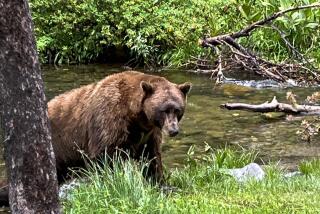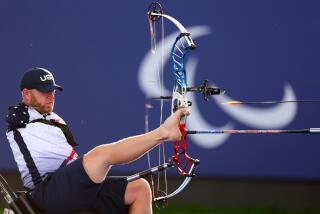PROFILE : On the Straight and Arrow : Barbara Gregory sees bow hunting as part of man’s history, right up behind fire and the wheel.
Within an hour, the sun will drop behind the mountains of Puerco Canyon above Malibu, streaking the sky pink and orange with a silver, shimmering ocean beyond.
But taking in the view isn’t the main thing on Barbara Gregory’s mind as she steps from her car and begins walking silently down a steep ravine. Dressed in bush-colored clothes with a pouch of arrows fastened around her waist, Gregory grips a bow in one hand and scans the hillside with a pair of binoculars.
“I don’t think we’ll have any luck tonight,” she says quietly after a few moments. “If the deer heard us, they’re in the next canyon by now.”
In the male-dominated sport of hunting, Gregory, a project coordinator for a computer company in Camarillo, is a minority. But what sets her apart now, she says--what recently has placed her recreational activity at the center of a heated debate-- has nothing to do with gender. She is among a small number of hunters throughout the state who use arrows instead of bullets to kill their prey.
“I think an animal shot with an arrow dies more quickly,” Gregory says, holding out an aluminum arrow whose tip resembles a multi-sided scalpel. “What causes an animal to die is bleeding. When you shoot with a gun, there is less bleeding.”
She knows that many others do not share her views. Last month, a California Superior Court judge ruled in favor of animal rights activists and canceled this year’s archery hunting season for bears. Activists have argued that bow hunting is a “fundamentally cruel” sport that often results in high wounding rates and lingering, painful deaths. Efforts are now being made to ban bow hunting in the state altogether.
Gregory, from Newbury Park, along with several other Ventura County bow hunters, expresses anger that the sport might be taken away from her. Bow hunting, she says, is much more than just recreation. It also is a part of man’s history, an invention she says ranks right up there behind fire and the wheel.
“Hunting is something that’s been done beyond memory. It has been a matter of survival,” she says emphatically. “It should be preserved.”
Like many others who share her penchant for the sport, Gregory believes that bow hunting prevents modern man from denying his role as predator. People who condemn bow hunting while buying their meat in neatly wrapped packages at the supermarket in cellophane, she says, are hypocrites.
“How do they think animals are killed, anyway?” she asks.
When co-workers see photographs of Gregory standing next to a deer with arrows protruding from it, which she has pinned beside archery trophies on her office wall, they sometimes ask her how she could shoot a defenseless animal.
“I say, ‘Have you ever been to a cattle farm?’ All they’re doing is paying someone else to do the killing for them.”
Gregory started hunting six years ago, when she was 32. A man she was dating took her into a field, where the first animal she shot was a rabbit. It was then, she says, that she learned how to skin and clean an animal, a task she still finds unpleasant.
Gregory eats the meat of hunted animals, and has tasted several varieties not available at her local market. “Bear is very good. It’s different than beef. I’ve also had chili with elk meat and rattlesnake meat,” she says. Deer meat, she adds, “is great on the barbecue.”
Gregory’s boyfriend, Newbury Park horseshoer Bob Smith, also is an avid bow hunter. Like Gregory, he disagrees with critics who charge that bow hunting results in higher wounding rates than guns.
“We have to get closer to an animal” than hunters armed with firearms, “and so the chance of wounding an animal is actually less,” says Smith, a trophy-winning archer who grew up in Oregon and bow hunted as a child to put meat on the table. Smith, who has killed bear, elk and deer with archery equipment, says that responsible bow hunters wouldn’t take a shot unless they were certain it would be fatal.
And both Smith and Gregory are quick to argue with critics who say that bow hunting should be banned because it is an ineffective means of killing an animal.
“There’s nothing that walks this earth that can’t be killed with a bow and arrow. Most animals won’t make it 50 or 60 yards if you get a vital shot,” Smith says. Animal rights activists, he says, “are just trying to do away with bow hunters because we’re an easy target.”
To keep their archery skills honed, Gregory and Smith practice regularly at one of two indoor archery lanes in Ventura County. Although not all archers who shoot there also bow hunt, Gregory says, a large percentage of them do. She estimates that there are several hundred bow hunters throughout the county.
Several times a year, Gregory also attends “3-D” archery events held throughout the state. Life-size replicas of animals are placed on a hillside, and archers compete for trophies by trying to get their arrow closest to the animal’s “kill zone.”
“It’s just like a bowling league,” she says, “except we shoot at animals.”
UP CLOSE BARBARA GREGORY
Age: 38.
Profession: Project coordinator for Unisys, a defense contractor in Camarillo involved in computer hardware and software development.
Hobby: Bow hunting.
Pets: One cat.
Attitude toward animal rights activists: “I think they’re pretty desperate. Next it will be fishermen. Then it’s rodeos. Then it’s horse riding because horses aren’t designed to carry weight.”
Possible solution for the hunting debate: “Why don’t they let us shoot animals and give the meat to the hungry? There’s a novel idea.”
More to Read
Sign up for Essential California
The most important California stories and recommendations in your inbox every morning.
You may occasionally receive promotional content from the Los Angeles Times.









